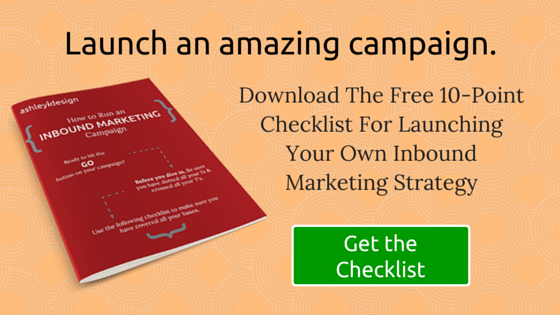
How to Transition From Traditional Marketing to Inbound Marketing
Can old dogs learn new tricks?
Short answer: Yes!
Long answer:
It depends on the motivation, the program and the end result this "dog" is looking for.
When it comes to transitioning from traditional to inbound marketing, this same question applies.
Numbers don't lie, take a look:
- The number of marketers who are planning to apply inbound marketing rose from 60% last year to 85% in 2016.
- Almost 70% of businesses are either using a marketing automation platform (like HubSpot) or implementing one
- Inbound marketing practices produce 54% more leads compared to traditional outbound marketing
As you can see, implementing inbound marketing has brought life back to businesses. It opened new doors on how to build better relationships with customers.
By now the only question left is: are you ready to take the leap?
If you answered "Yes", then let me show you a few steps on how to transition from traditional to inbound marketing.
A quick reminder, though, I'm not advocating that you abandon outbound marketing. What I'm asking is to let inbound marketing support your traditional marketing strategies to widen your pipeline.
My goal is to let you see another way of reaching out to leads and converting them into customers.
By doing so, you will create more opportunities using fewer resources than before (i.e. traditional marketing).
Follow and emulate industry leaders
Each industry has a "lead" dog who knows how to get things done.
With inbound marketing, we're talking about people who have been in the trenches for years.
These experts built a strong following because they preach inbound marketing as good as how they practice it:
Following these leaders will shorten the learning curve and get your inbound marketing up to speed. You'll discover what works and what doesn't while doing inbound marketing the correct way.
Additionally, you should read these top 17 inbound marketing blogs to keep you updated on what's happening in the industry:
- Copyblogger
- Danny Brown
- HubSpot
- IMPACT Branding & Design
- Inbound Marketing Agents
- Jeff Bullas
- Kuno Creative
- Lynton
- PR 20/20
- Precision Marketing Group
- ProBlogger
- SEOMoz
- Seth Godin
- Social Media Examiner
- The Inbound Marketing Company
- WebInkNow
- Weidert Group
Switch from Being Product-centric to Customer-centric
Inbound marketing is all about building customer relationships based on trust, likeability and authority.
Find ways to publish content about customer pain points and how you can solve them.
Look for content that best resonates with your audience. That means:
- No selling.
- No promotion.
- No advertisements.
Be a consultant rather than a vendor. Aim at making your customer's lives better by educating them.
The best content to start with is "How-To" articles, video tutorials, low-ticket online courses, cheat sheets, whitepapers or downloadable eBooks.
Converting Offline Marketing Materials into Digital Assets
Speaking of content, you can always use old-school marketing as leverage to kick start your inbound marketing strategy.
HubSpot has listed 8 ways to do just that.
Here they are:
- Turn printed newsletters into emails
- Reuse tradeshow banner designs as social media images
- Convert banner ads to calls-to-action on blogs
- Repurpose whitepapers as eBooks
- Create infographics out of research reports
- Find inspirations on brochures when creating web pages
- Turn direct mail into email marketing
- Use radio ad copy as twitter posts
Make Your Website More Inbound-y
Your website is your gateway to the online world, and I can't think of any reason for embracing inbound marketing without an inbound-focused website.
So where do you start?
The first thing to do is to reconfigure your site to reflect your customer's goals and motivations.
For example, a big hero image on the homepage representing your ideal customer plus a headline that articulates customer benefits.
Next, create a blog which contains valuable content relevant to your customer's needs. Then, create premium content like eBooks, whitepapers, case studies or mini e-course customers can access in exchange for their email address.
Lastly, make your site easy to navigate and attractive ... especially on mobile devices.
That means choosing a color scheme that represents your branding or your customer's personality. Or, hire someone who has been designing websites for businesses transitioning from outbound to inbound marketing.
Invest in an Inbound Marketing Platform
An inbound marketing platform ties everything together – from content creation to lead conversion. It helps to streamline the process and automate workloads.
In other words, an inbound marketing platform allows you to do more in less time, and have the ability to make decisions based on solid facts.
Why?
Because most platforms have built-in analytics that show what makes your strategy work or why it doesn't.
To know more about inbound marketing platforms and tools, please read my article, "19 Tools To Easily Manage Your Inbound Marketing".
Inbound marketing platforms allow you to do more in less time, and have the ability to make decisions based on solid facts.
(Click to Tweet)
Befriend Analytics
Speaking of analytics, no amount of "guess work" can trump a well-defined strategy based on figures. Investing in analytics keeps your business updated with the changing trends in the digital world. It lets you stay ahead of the curve while allowing you to monitor your competitor's performance … or lack thereof.
Analytics has a big part in making sure you understand your customer's psyche – especially in today's setting.
Build an Inbound Marketing Plan
Everything starts from here.
An inbound marketing plan consists of a set of routines that needs to be carried out periodically (daily, weekly, monthly, quarterly, and annually).
It helps you prioritize activities that will let you connect with audiences and build loyalty over time.
Use this simple inbound marketing plan from HubSpot as reference:
- Define Your Buyer Personas
- Outline Your Marketing Triggers
- Create a List of Keywords
- Set Your Inbound Marketing Goals
- Outline Your Content Strategy
- Design Your Lead Nurturing Process
- Create a Conversion Focused Blogging Strategy
- Implement an Inbound Marketing Platform
- Recruit a Team of Inbound Marketing Experts
In The End …
I admit it's challenging to try something you haven't done before -- one that involves money, time and resources.
If this is something you're worried about, then you can start with publishing content based on topics your customers love. Reach out to them (online or personal). Address their concerns and discuss issues that affect them through your blog posts.
Then start building your email list and online presence. Make so much noise that influencers can't help but notice you.
Soon, you'll find your business get exposure from leading figures in your industry – along with new business opportunities.
And while these things are all happening, continue with your traditional marketing activities.
But this time, integrate your online strategies by inviting clients to like your Facebook page or follow you on Instagram.
Transitioning to inbound marketing doesn't have to be hard.
All it takes is consistent effort in delivering the best value to your customers.
I help businesses and marketers build marketing and sales systems that drive leads and scale with ease.
Not sure where to start? Take my marketing quiz and get personalized next steps.





